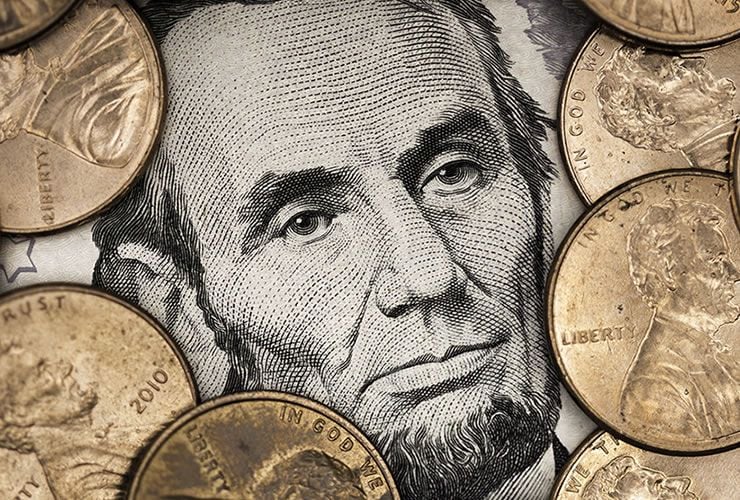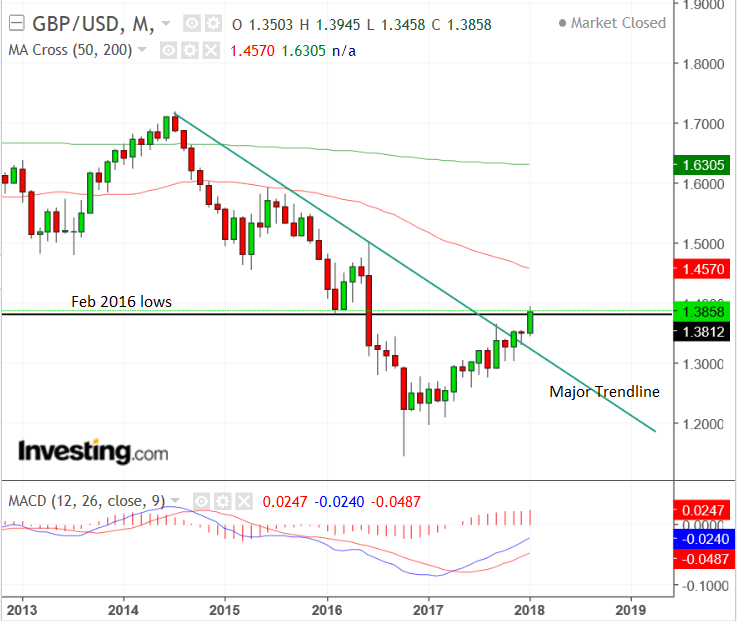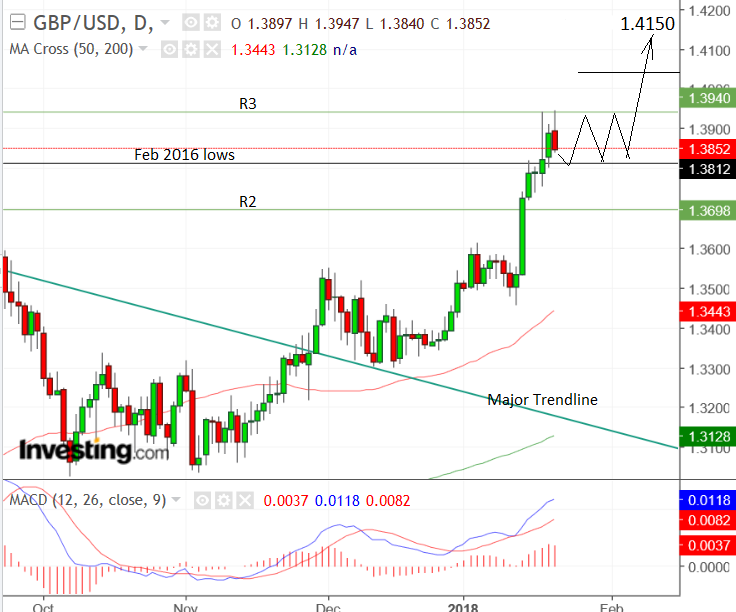Pound-to-US Dollar Rate Forecast for the Week Ahead

The Dollar is expected to weaken at the start of next week as the US government shuts down from lack of funds, charts show the pair is still in an uptrend but resistance thickening.
The Pound-to-Dollar exchange rate climbed strongly in the previous week reaching our upside target at 1.3900 but now it has run into a fresh tier of resistance at the 1.3840 February 2016 trough low and the R3 monthly pivot at 1.3900, and the exchange rate has pulled back down to its current exchange rate of 1.3858.
The monthly timeframe chart below clearly shows the long-term support and resistance level at the February 2016 lows and the way the exchange rate interacted with it last week.

The exchange rate has however failed to decisively break above this point and there remains a risk of a deeper pull-back down after contact, since these sorts of key levels attract increased supply from short-term traders betting the market will fall after touching the level.
A further impediment to progress is the location of the R3 monthly pivot at 1.3940, virtually coinciding with last weeks highs of 1.3945.
Again this may not be a coincidence but rather indicative of short-term selling at the level of the pivot as technical traders bet on the market going down.
Pivots are often points of reversal for prices and there is a risk the market could correct quite deeply from here, especially given it is the R3 monthly pivot which is rarely reached because it is spaced at such an extreme from the month's open.
Above there is 1.4000 a key psychological level and another point at which short-term bears will be looking for a pull-back as many traders decided to take profit at major round-numbers, thus often generating contrary forces at these levels.
Whilst the trend still remains up we would want to see a clear break above 1.4050 for confirmation of an extension higher, to an initial target at 1.4150, but see this as unlikely in the short-term given how overextended the market is; and there is a possibility the exchange rate may go sideways for a time before the next cycle higher begins.
Advertisement:
Get up to 5% more foreign exchange by using a specialist provider to get closer to the real market rate and avoid the gaping spreads charged by your bank when providing currency. Learn more here.
Data and Events for the Dollar
The main event to affect the Dollar in the coming week is the news of the government shutdown late on Friday after the Senate failed to pass an extension of the government's borrowing limit.
The US government has essentially run out of money and so all non-essential services will now have to be shut down.
From the perspective of the Dollar, it will be a negative event judging from previous shut-downs.
"The last time the U.S. government was officially shut down was in October 2013 for 16 days. The dollar declined as it has now the month leading up to the shutdown. Then halfway through, it bottomed out as investors moved on," says BK Asset Managment Managing Director Kathy Lien.
"When Congress passed the Continuing Appropriations Act of 2014 that suspended the debt limit until February, the dollar index actually extended its losses before bottoming a week later," she continues.
She underscores the fact that the shutdown did not seem to impact negatively on growth in the past, however, and so it is not expected to be negative for the Dollar long-term.
As far as hard data goes, the next big release for the Dollar is fourth quarter GDP on Friday at 13.30 GMT, which is forecast to moderate to 3.0% compared to the same quarter in 2016, from 3.2% previously.
Data and Events for the Pound
Two big releases really stand out for the Pound next week: Employment data and fourth quarter GDP.
Employment data for November is out on Wednesday at 9.30 GMT and is forecast shows the unemployment rate staying fixed at 17-year lows of 4.3%.
Wages are also likely to be in focus as they influence inflation which in turn influences interest rates and Sterling.
Higher wages, equal higher inflation, equals higher interest rates, equals higher Pound.
Wages rose by 2.5% in the previous month of October compared to a year ago and are expected to rise the same in November.
Unfortunately for workers this is a half a percent below inflation at 3.0%, which means they are essentially getting poorer.
This suggests consumption may fall as people tighten their belts which will reduce growth.
Evidence of wages rising in December, however, from a new survey conducted by IHS Markit suggests a possibility of an upside surprise in Wednesday's earnings data, although the official data will be for the month before the IHS Markit data.
The other major release in the week ahead is Q4 GDP on Friday at 9.30.
Consensus estimates are for GDP to equal 1.4% in Q4 from 1.7% in Q3 reflecting the slowdown in the economy due to the corrosive effects of high inflation and businesses holding back from making investment decisions due to Brexit uncertainty.
A fall to the estimated 1.4% would mean the annual growth rate on a quarterly interval comparison basis will have fallen to lows not seen since 2009 - over eight years ago during the financial crisis.
(Image courtesy of tradingeconomics.com)
The quarterly rate, however, is forecast to remain at 0.4% like Q3, and the year-on-year data may reflect a more negative situation than the quarterly figures suggest.
The economy has shown and will continue to show resilience when GDP data is released, says IHS Markit Economist Bernard Aw.
"Preliminary estimates of UK GDP for the fourth quarter are eagerly awaited for confirmation that the economy continues to show resilience on the face of Brexit uncertainty," says Aw.
From a growth perspective, the outlook may be improving after recent conciliatory comments from French President Emmanuel Macron and other leading EU figures suggested the UK could have a bespoke trade deal after Brexit, and consequently a softer-landing for the UK economy.
Get up to 5% more foreign exchange by using a specialist provider to get closer to the real market rate and avoid the gaping spreads charged by your bank when providing currency. Learn more here.

